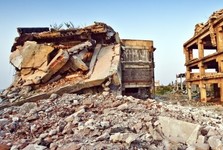
UCLG is participating in the 2017 Global Platform for Disaster Risk Reduction, taking place on 22-26 May 2017 in Cancun (Mexico). This gathering will provide the first opportunity to review globally the implementation of the Sendai Framework adopted in 2015.
You will find all the information in the links below:
--------------------
In recent years a number of experts and specialists, studies and reports have drawn our attention to the great changes taking place on our planet, and the sometimes dramatic consequences these have for man and nature. It is not so much the disasters that are concerning, but rather their frequency, intensity and the incredible damage to lives and infrastructure and the potential humanitarian crisis that they cause.
Following the example of the international community, local governments have always clearly expressed their solidarity with those affected by disasters. All over the world, local governments have mobilized tremendously for the victims of the Tsunami in Asia and the Earthquake in Haiti, for example. This solidarity was the first response to urgent and immediate needs (fundraising, transportation of equipment such as water pumps, the collection of medicines, etc.). It also fits with a long-term approach, since local governments are involved in the efforts to reconstruct municipal and local infrastructure, such as roads, schools, clinics, markets and transport; and above all to restore public services, so that all activities can function as normal.
Like other institutions, local governments, due to their close proximity to citizens, have a role to play in raising awareness and consciousness among their populations in order to reduce the risk of disaster. Alongside this function, they can also be at the centre of a scheme for collecting and disseminating information with other partners. The central government must consider the role of local governments within national platforms and thus incorporate them within the process of formulating disaster risk reduction policies.
In developing its strategy, each local government takes part in reducing the risk of disaster by putting in place policies that respect the environment and take into account appropriate urban planning, transport schemes, energy efficiency and strategies to prevent climate change, desertification and the greenhouse effect. Action with regard to social housing and increasing land reserves for society's poorest – apart from those in illegal areas (flood zones, unconstructible areas) – as well as reducing the impact of disasters on vulnerable populations, must also be considered.
In 2005, 168 countries present in Kobe (Japan) approved the Hyogo Framework for Action 2005-2015, which aimed to achieve “a substantial reduction in losses to lives and to social, economic and environmental assets when hazards strike” through five priority actions:
-
Ensure that disaster risk reduction is a national and a local priority with a strong institutional basis for implementation;
-
Identify, assess and monitor disaster risks and enhance early warning;
-
Use knowledge, innovation and education to build a culture of safety and resilience at all levels;
-
Reduce the underlying risk factors;
-
Strengthen disaster preparedness for effective response at all levels.
In an increasingly urbanising world, the concentration of populations living in cities considerably increases the impact of disasters on citizens, as well as on material assets and the economy in general. This was demonstrated by the disasters in Bam, Istanbul, Kobe, Manila, Mexico and New Orleans. Local governments must adopt local disaster risk reduction strategies. This may be done in partnership with the central authorities, to better define roles and responsibilities with regard to the risk reduction strategy.
In many countries, local governments have a legal arsenal at their disposal that allows them to reduce disaster risks, such as town and land use planning. They have the possibility to use the principles of precaution and vigilance to anticipate and reduce the risk of disasters.
In 2008, during the World Council in Istanbul, our Organization noted and adopted a position on the theme of disaster risk reduction. This document reaffirms the commitment of local authorities throughout the world to anticipate and reduce disasters and to act, if necessary, when faced with humanitarian crises. Since then, UCLG, with its partners, has carried out concrete actions related to disaster risk reduction, such as training sessions and raising awareness of elected officials and experts in Africa, as well as giving its support to the UNISDR "Resilient Cities" Campaign. More than 1,000 cities have joined this important initiative to raise awareness about disaster risk reduction.
Local and regional authorities key partners in disaster risk reduction
The United Nations World Conference on Disaster Risk Reduction, which took place in Sendai, Japan, between 14 and 18 March 2015, resulted in a historic agreement by the international community to reduce disaster risk, and recognized local authorities and the local level as essential to achieving this. Strongly represented at the Conference, local and regional authorities showed the world that they are fully engaged in the risk reduction process at all levels.
For the first time, the Sendai Framework for Disaster Risk Reduction 2015-2030 recognizes that local authorities have a crucial role to play in disaster risk reduction. The local level and local authorities are mentioned many times in the final text.
The Sendai Declaration of Local Authorities emphasizes the need to connect the Sendai Framework for Action with the fight against poverty, the urban agenda, the fight against climate change and the Post-2015 agenda.
Related information:
